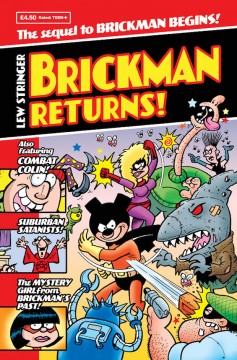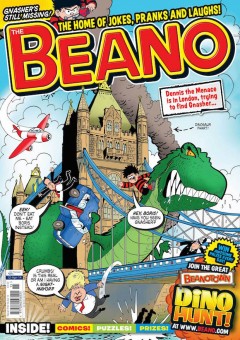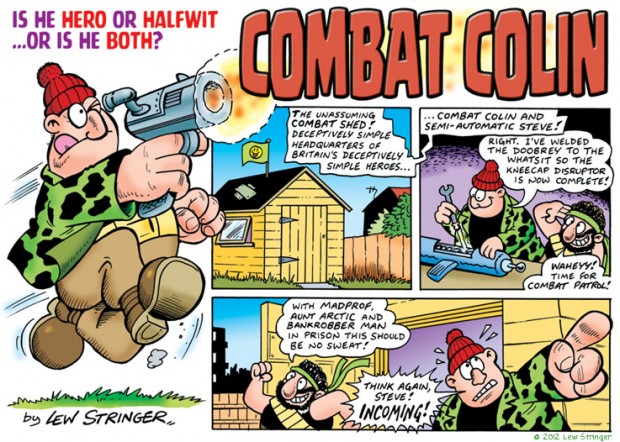“Newcomers today want to start off doing their great graphic novel but my advice would be to start small” we talk to Lew Stringer about the Beano, Aces Weekly and Combat Colin
 At this weekend’s Birmingham Comic Con, part of the Birmingham Comics Festival, our roving reporter Olly MacNamee caught up with Brit comic stalwart Lew Stringer. man who has made a career in the UK and abroad as both a versatile writer and artist, with comical comicstrips as diverse as The Beano and Combat Colin. We talk about his early career, his republished Brickman comic as well as some sound advice for would-be comic book creators.
At this weekend’s Birmingham Comic Con, part of the Birmingham Comics Festival, our roving reporter Olly MacNamee caught up with Brit comic stalwart Lew Stringer. man who has made a career in the UK and abroad as both a versatile writer and artist, with comical comicstrips as diverse as The Beano and Combat Colin. We talk about his early career, his republished Brickman comic as well as some sound advice for would-be comic book creators.

Olly MacNamee: Lew, you seem to be comfortable in both the world of children’s comics (eg. The Beano) as well as more adult affair (e.g. Viz). In fact, your own creation, Brickman, would seem to fit somewhere between the two. Which do you prefer, or do they both bring their own rewards?
Lew Stringer: I find them both satisfying and it makes life more interesting to produce comics for different age groups. Years ago I was also writing stories for pre-schoolers on CiTV Tellytots magazine so it required quite a shift mentally to be writing Sooty one day and Suicidal Syd the next. On balance though I think I prefer doing material that fits between the two, like Brickman and Combat Colin.
OM: With the recently released Brickman Returns, could we be seeing more of this guy in the future?
LS: It collects all the strips I did for Image Comics that appeared in Elephantmen, plus back ups with a classic Combat Colin strip and the Suburban Satanists, which had appeared in a Swedish comic. Brickman is a character I created for fanzines back in 1979 and Brickman Returns brings his story to a conclusion, but who knows? He has a habit of making comebacks but nothing new is planned for him in the foreseeable future. I want to continue self-publishing alongside my mainstream work but I’ll be reviving some of my other characters such as Combat Colin and Derek the Troll for future comics.
OM: Speaking about Brickman, reminds me that you cut your teeth in the wonderful funky world of fanzines. How has the world of UK comic changed for better or for worse over time?
LS: Sadly there are far less comics available in newsagents now. There’s also too much dependency on licensed titles but the news trade expects that now so it’s difficult to launch new comics on the newsstand. On the positive side, the growth of the graphic novel market has been marvellous, bringing in more diversity of art styles and a richness of storytelling that was seldom seen decades ago. The increased number of comic shows has been very beneficial too, both for readers and creators. It’s hard to believe that a few years ago we were lucky if we had one convention a year in the UK. Now there seems to be at least one event every weekend, providing ideal opportunities for creators to sell their comics directly to the readers.

OM: With The Dandy defunct, do we have a sustainable market for the funny pages in the UK anymore?
LS: Well, everyone likes a laugh so you’d think so. The main problem as I see it is that most of today’s children haven’t developed the habit of buying comics regularly so I think the days of periodicals are numbered. Perhaps the future lies in graphic novels. The Phoenix seems to have the right idea of adopting the European model, serialising strips in the weekly, then collecting them into albums.
OM: Brickman has appeared in Image’s Elephantmen and you contribute to Grindhouse from Dark Horse – Is comedy universal or have you had to accommodate your work to suit the tastes of comics published in the USA?
LS: I didn’t change it too much. I avoided British cultural references but that’s about it. I don’t think our humour is too different these days.
OM: You created Suburban Satanists for Herman Hedning over in Scandinavia. An English translation appeared in the British anthology Bomb Scares, and I understand there’s a plan for them to return, both in that comic and their own. Is that correct?
LS: Yes, I definitely intend to publish a Suburban Satanists comic either this year or next and probably a few page in the next Bomb Scares too. The strip ran for several years in Scandinavia so there’s plenty of material that has never been seen in the UK.
OM: And, of your other adventures in the world of comics, there’s The Daft Dimension for Dr Who Magazine and strips in Toxic, can you tell us a little about those and where else we can find your work appearing?
LS: Toxic is the most popular magazine for boys in the UK, selling around 54,000 copies an issue, and has been around since 2002. It’s mainly feature based but there are a few strips. One of which is Team Toxic, that I write and draw, featuring Doc Shock and his group of monsters saving the world on a regular basis from foes such as Butt-Face, Sick Squid, Frankendrac and others.
The Daft Dimension in Doctor Who Magazine is a mini-strip that basically spoofs anything related to Doctor Who, so we have Dalek focus groups and Zarbi with a grudge about being seen as just big ants.
I also contribute occasionally to Aces Weekly, the digital anthology published by David Lloyd, where I do brand new Combat Colin adventures. That’s a great title to work for and everyone should check it out.

OM: Are there any characters you have yet to tackle, but have a burning desire to tackle? Or, any creator owned characters you want to unleash?
LS: I’ve never had any longing to take on characters created by others, but if they’re offered to me I always enjoy doing them and give it 100%. I’ve recently started doing Pup Parade (The Bash Street Dogs) for The Beano, which is very enjoyable as they were characters I liked as a kid.
OM: And finally, as an artist of some standing, is there any advice you could give aspiring artists who want to break into comics? Is self-publishing the way forward do you think?
LS: Definitely! I started in fanzines and small press comics and it’s a perfect way to develop your skills, listen to feedback, and build interest from readers and editors. I know a few newcomers today want to start off doing their great graphic novel but my advice would be to start small, do one-off mini-comics, contribute to other indie comics, set up a blog or digital showcase of some sort and do things gradually. Don’t try to run before you can walk. That big graphic novel can wait, and while you’re developing your skills with smaller projects it’ll turn out better when you do commit to the Big Idea.
Lew Stringer’s blog is always worth a read, and can be found here.
Olly MacNamee teaches English and Media, for his sins, in a school somewhere in Birmingham. Some days, even he doesn’t know where it is. Follow him on twitter @ollymacnamee or read about his exploits at olly.macnamee@blogspot.co.uk. Or don’t.


